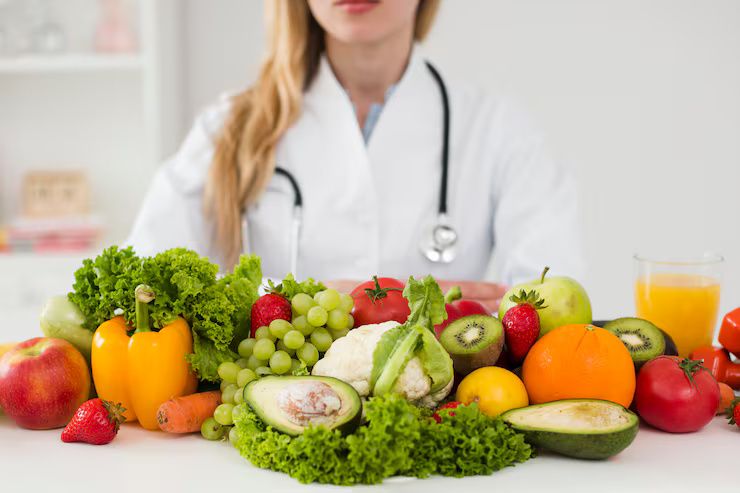Healthy nutrition refers to the practice of eating a balanced and varied diet that supports the body’s growth, energy needs, and long-term well-being. It involves consuming appropriate amounts of macronutrients (carbohydrates, proteins, fats), micronutrients (vitamins, minerals), fiber, and water. The goal is to meet nutritional needs without excess calories, supporting physical and cognitive functions
Healthy nutrition matters because:

-
It prevents chronic diseases such as heart disease, diabetes, obesity, and certain cancers.
-
It supports early childhood development, immune function, and cognitive performance.
-
It helps older adults maintain strength and mobility, and supports mental health for all ages.
Who it affects:
-
Everyone, across all ages and demographics.
-
At-risk groups include children, pregnant people, people with chronic illnesses, and older adults.
Problems it helps solve:
-
The rising prevalence of non-communicable diseases due to poor dietary choices.
-
Nutrient deficiencies in populations that rely on calorie-dense but nutrient-poor foods.
-
Food insecurity compounded by lack of access to affordable, healthy options.
Recent Updates – Changes, Trends, or News from the Past Year
Here are some recent developments (within roughly the past year):
| Trend / Update | Description |
|---|---|
| Plant-based alternatives grow | More people are adopting legumes, whole grains, nuts instead of processed meats due to ethics, health, and environmental concerns (2024–2025). |
| Ultra-processed food awareness increases | Public health campaigns have raised awareness of risks associated with highly processed foods (e.g. “Additives and Health” reports in 2025). |
| Nutrition labeling evolves | Some countries updated front-of-package labeling, requiring clearer warning labels for high sugar, salt, or fat (e.g. “high sugar” stop-sign labels introduced in parts of Latin America in 2024). |
| Personalized nutrition apps emerge | Growth in apps offering diet plans based on genetics, microbiome, or metabolism—evident in app releases and updates in late 2024 and early 2025. |
| Micro-nutrient fortification | Increased fortification of staples like flour, rice, or salt with iron, folic acid, or iodine—new policies enacted beginning around mid-2024. |
Laws or Policies – How Government Programs and Regulations Affect Healthy Nutrition
Government rules and programs play a vital role in shaping healthy nutrition:
-
Nutrition labeling laws: Many countries now require nutrition facts panels and standardized front-of-package labeling to help consumers make informed choices.
-
Food fortification standards: Laws mandate adding essential vitamins and minerals to staples (e.g., folic acid in flour, iodine in salt, iron in cereals).
-
Dietary guidelines: National dietary guidelines (e.g., India’s 2020–2025 guidelines) are promoted through public health initiatives and education.
-
Subsidies and taxes: Policies subsidizing fruits, vegetables, and whole grains can make healthy options more affordable; conversely, sugar-sweetened beverage taxes discourage consumption.
-
School meal programs: Government schools often must meet nutrition standards for meals—many countries have updated these standards in recent years.
-
Public awareness campaigns: Governments fund campaigns (e.g., “Eat Right, India” launched 2023–2024) to encourage balanced diets and reduce junk food intake.
These laws and programs work together to shape availability, affordability, and awareness of healthy nutrition across populations.
Tools and Resources – Helpful Tools, Apps, Calculators, Websites, Templates, or Services
Here are practical resources for everyone—from individuals to educators:
-
Online nutrient calculators
Platforms like MyFitnessPal, Cronometer, or India’s NIN Interactive Healthy Plate tool allow tracking of calories and nutrient intake. -
Dietary guideline tools
Downloadable guides and meal-planning templates from national health agencies (e.g., Indian Council of Medical Research) help translate broad recommendations into daily meals. -
Front-of-package label explainers
Interactive websites explain how to read warning labels and identify high-sugar or high-salt products. -
Recipe and meal planning apps
Apps like SuperCook or Cookpad offer healthy recipe suggestions based on available ingredients. -
Fortification atlases and maps
WHO or national nutrition surveillance portals provide maps showing fortification coverage of foods (e.g., WHO’s global salt iodization database). -
Educational templates
School-based templates for balanced plates, infographics, and pamphlets from ministries of health or nutrition organizations. -
Nutrition helplines
Some countries operate toll-free or online chat services staffed by dietitians to answer public queries.
Frequently Asked Questions
What is “nutrient-dense” food?
Nutrient-dense foods provide high levels of vitamins, minerals, fiber, and protein with relatively few calories—for example, vegetables, legumes, whole grains, lean meats, and low-fat dairy foods.
How much water should I drink each day?
General advice is about 2–3 liters per day for adults, depending on activity, climate, and health status. Remember, water from foods counts too.
Are supplements necessary to eat healthy?
Most healthy individuals who eat diverse foods don’t need supplements. Exceptions include pregnant people (folic acid), older adults (vitamin B12), or those with clinical deficiencies diagnosed by a doctor.
What’s a simple way to start improving diet quality?
A practical first step is adding one serving of fruit or vegetables to a meal every day, and swapping sugary drinks for water or tea.
Can packaged foods be part of a healthy diet?
Yes—if you check labels for added sugars, salt, and saturated fat, and prioritize minimally processed options. Moderation is key.
Final Thought
Focus on balance, variety, and portion control. Small, consistent choices—like choosing whole grains over refined, having fruits instead of sugary snacks, and staying hydrated—add up to meaningful improvements in health over time.

